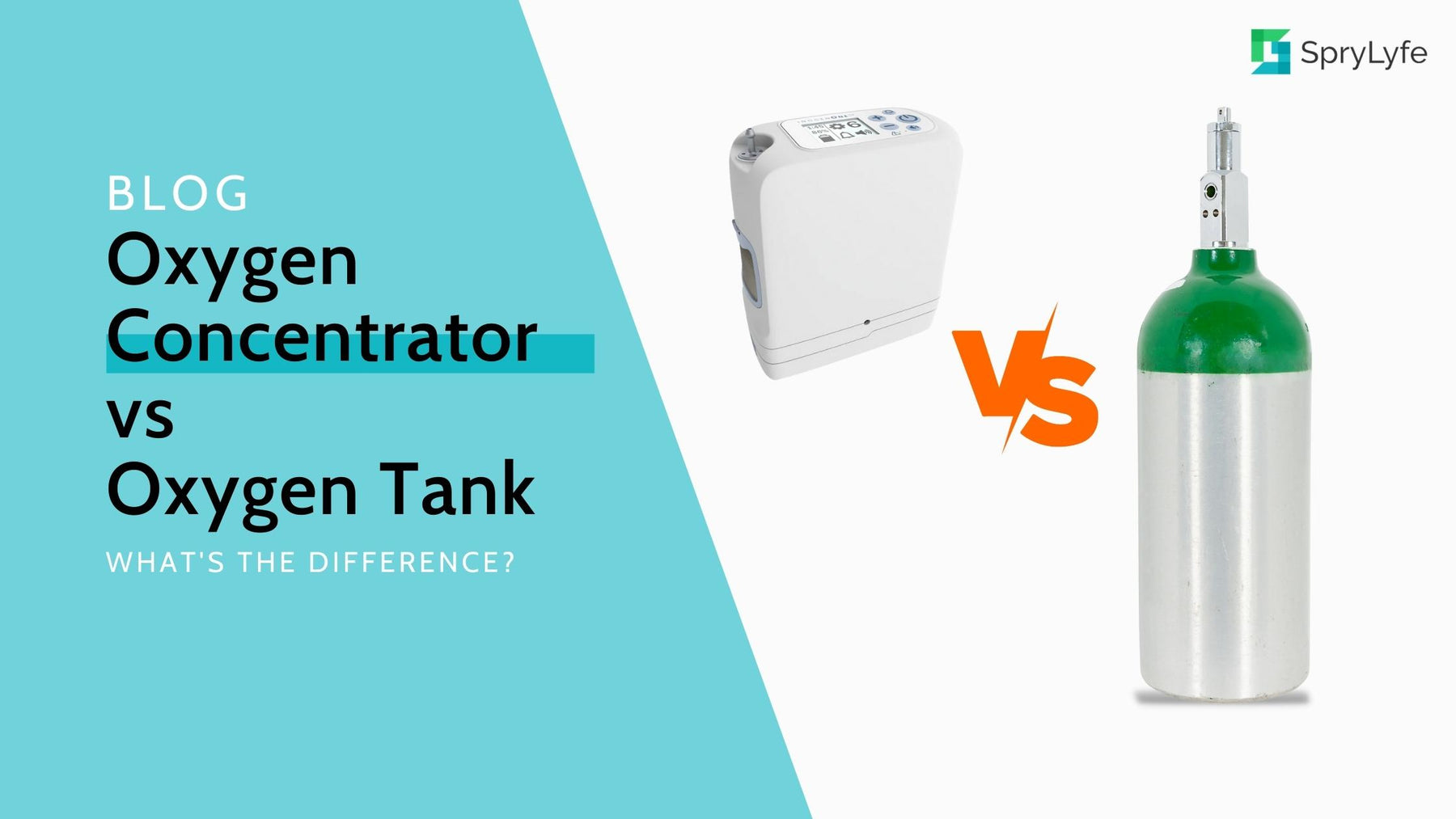
Oxygen Concentrator vs Oxygen Tank: What's the Difference?
Oxygen therapy or supplemental oxygen helps an individual get more oxygen in the event that they have COVID-19, COPD, and other lung diseases that cause them to have low blood oxygen levels. Included under oxygen therapy are oxygen tanks and oxygen concentrators.
So oxygen concentrator vs. oxygen tank: which should you choose?
While an oxygen concentrator may be considered to be better than an oxygen tank when considering its long-term use, choosing between the two is still a matter of preference. Weighing in the things to consider in choosing between the two and getting to know more about the two medical devices is important to do.
What To Consider In Choosing Between An Oxygen Concentrator And Oxygen Tank
|
Oxygen Tank |
Oxygen Concentrator |
|
|
Size |
Variable |
Variable |
|
Weight |
Variable (Between 10 to 60 kilograms) |
Variable (15 kilograms for stationary; 1 to 3 kilograms for portable) |
|
Mobility and Portability |
Mobile but not portable; not allowed for travel by US FAA |
Mobile and portable; allowed for travel by US FAA |
|
Safety |
Can cause pure oxygen leaks |
Does not cause pure oxygen leaks |
|
How the Device Works |
Stores pure oxygen that it delivers at specific doses to the patient |
Processes the surrounding air and delivers it at specific doses to the patient |
|
Pros |
|
|
|
Cons |
|
|
In choosing between an oxygen concentrator and an oxygen tank, it’s important to take a step back and think about how it can fulfill its intended use and how its use will affect the way you live. Things to consider in choosing between the 2 medical devices include purpose, size and weight, mobility and portability, cost, safety, and the use of other components.
Size And Weight
Oxygen tanks or oxygen cylinders differ in size and weight depending on the model. Usually, though, oxygen tanks can provide medical-grade oxygen for 5 hours at a rate of 2 liters per minute, with a capacity of 680 liters of oxygen. They can have lengths of up to over 60 centimeters and can weigh between 10 to 60 kilograms.
Similarly, oxygen concentrators also differ in size and weight depending on whether they’re stationary or portable.
Stationary oxygen concentrators typically weigh up to 15 kilograms, delivering oxygen up to 10 liters per minute. On the other hand, portable oxygen concentrators are smaller, weighing 1 to 3 kilograms, and can last between 4 to 10 hours before they run out of oxygen.
Mobility And Portability
Mobility and portability are major considerations in patients who usually travel. This is because, while oxygen tanks are mobile through wheels or carts that can be used to carry the tank, they aren’t allowed by the United States Federal Aviation Administration for air travel so compressed oxygen tanks or liquid oxygen tanks can’t be brought to travel on air.
On the other hand, portable oxygen concentrators are designed for easy portability and for being travel-friendly. There are portable oxygen concentrators that can be used at altitudes as high as 10,000 feet. They’re even allowed by the US FAA and come with travel bags and additional charges.
Read more about driving with oxygen concentrators
Cost
Oxygen tanks aren’t costly at first glance, requiring only a hundred dollars upfront. However, they would require maintenance wherein the users would need to change and refill the tanks, which will be expensive in the long run.
Meanwhile, oxygen concentrators are costly upfront, requiring thousands to several thousand dollars at the initial purchase. However, long-term investment in this medical device sums up to a lesser cost because it doesn’t need maintenance, in contrast to that of oxygen cylinders. Similarly, other oxygen supplies such as a nasal cannula, oxygen tubing, and oxygen masks may be needed to facilitate the delivery of oxygen from the device to the body. If you don’t have these materials yet, you should consider purchasing them in bundles together with the medical device to get a discount and to lessen the hassle of looking for them.
Read more about the cost of portable oxygen concentrators here.
Safety
While both of these medical devices are generally safe, the instances of leaks must be taken into consideration. Oxygen tanks have a risk of leaking, resulting in pure oxygen filling the room where the oxygen cylinders are stored. On the other hand, oxygen concentrators only filter the surrounding air so there’s no risk of leaking pure oxygen in the room.
Oxygen Concentrator Must-Knows

In considering what medical device to buy, it’s also important to get to know more about the product. In buying an oxygen concentrator, for instance, it’s good to know how they work, their benefits, and their disadvantages.
How Oxygen Concentrators Work
The surrounding air is a mixture of air and contains only around 21% of oxygen. Oxygen concentrators work by collecting the air in the patient’s surroundings. The air will then be filtered, compressed at high pressures, then the oxygen will then be separated from other gas using a technology called pressure swing adsorption (PSA).
Upon going through these procedures, the oxygen concentrator will then release medical-grade oxygen for use by the patient.
Read more about how oxygen concentrators work in our detailed guide.
Oxygen concentrators also come in 2 different types namely pulse dose or continuous flow oxygen.
Portability and versatility
The most important benefit of oxygen concentrators is their portability and versatility, in that they’re easy to carry around and can be personalized based on the needs of the user. This is great, especially for patients who constantly need to travel for different reasons.
Because of their effectiveness, portability, and easy transportability, the World Health Organization (WHO) even supports the use of oxygen concentrators for COVID-19 patients in areas with increasing transmission.
Good long-term investment
Since they use the surrounding air, oxygen concentrators are also noted to not run out of oxygen, in contrast to oxygen cylinders that need a constant refill.
In connection to this, the upfront cost of oxygen concentrators may also be considered a benefit because, although you need to pay a high price at first, oxygen concentrators don’t need to be maintained so you don’t need to constantly spend money on it, unlike oxygen tanks.
Disadvantages Of Oxygen Concentrators
On the expensive side
The upfront cost is both an advantage and a disadvantage. Most patients who need the device immediately but don’t have the means to afford the expensive cost of oxygen concentrators become discouraged to buy the said device and opt for the comparably less expensive initial purchase of oxygen cylinders.
The need for a power source
Other cons of oxygen concentrators include the need for a battery or electric power, which may be dangerous for people who need oxygen all the time if the device is forgotten to be charged.
Noise
Another disadvantage of oxygen concentrators is the noise it makes due to the processes that the air goes through before the clean air is produced.
Oxygen Tank Must-Knows

Similarly, knowing how oxygen tanks work, their benefits, and their disadvantages are also important to consider especially when comparing and deciding on whether to buy an oxygen concentrator or an oxygen tank.
How Oxygen Tanks Work
Oxygen tanks contain liquid oxygen stored at a very high pressure of approximately 3000 PSI. They come in pressure regulators that will control the release of medical-grade oxygen at specific flow rates and pressure depending on the advice of the doctor. The oxygen is then delivered to the patient through a mask or a nasal cannula.
Benefits Of Oxygen Tanks
The benefits of oxygen tanks include features that are the opposite of the disadvantages of the oxygen concentrators. These include features such as the following:
- Ability to work without the need of a power source
- Production of fewer sounds while operating
- Lower upfront cost compared to oxygen concentrators.
Disadvantages Of Oxygen Tanks
It’s worth noting that the disadvantages of oxygen tanks are due to their sizes, contents, and cost. These are as follows:
- Heavy and can’t be transported easily
- More expensive in the long run
The amount of oxygen that oxygen tanks can provide is only limited to the oxygen they contain, meaning they need constant refilling and maintenance that may then make them more expensive than oxygen concentrators in the long run.

Frequently Asked Questions On The Use Of Portable Oxygen Concentrators
Now that you have understood the difference between an oxygen tank and a portable oxygen concentrator, it’s now time to answer other questions in mind to further help you choose between the two.
Which Is Better: Oxygen Tank Or Oxygen Concentrator?
The better choice for long-term investment is the oxygen concentrator because of portability, safety, and cost considerations. However, the choice still depends on your intended use and preference.
Is An Oxygen Concentrator As Good As Pure Oxygen?
Yes, but an oxygen concentrator is even better than pure oxygen. Oxygen concentrator delivers medical-grade oxygen to the patient and is therefore effective and safe in addressing the health problems of the patient. It’s better than pure oxygen because pure oxygen, especially in times of leaks, may result in fire.
What Are The Disadvantages Of An Oxygen Concentrator?
The disadvantages of an oxygen concentrator include its need for a power supply, its relatively noisier operation than oxygen cylinders, and the more expensive upfront fee than oxygen cylinders.
Are Oxygen Concentrators Safer Than Oxygen Cylinders?
Yes. The operation of oxygen concentrators is safer than oxygen cylinders. Oxygen concentrators use the surrounding air and process it to produce medical-grade oxygen, while oxygen cylinders store pure oxygen that may leak and cause fire when it fills the room.
Is It Worth It To Buy An Oxygen Concentrator?
Yes. It’s worth it to buy an oxygen concentrator. The cost needed to be spent upfront is offset by the fact that it doesn’t need maintenance that will incur additional fees, in contrast to buying oxygen cylinders.
Can You Get Too Much Oxygen From A Concentrator?
Yes, you can get too much oxygen from a concentrator if you use it without prescription. Oxygen toxicity or oxygen poisoning may occur if an oxygen concentrator is set too high. It’s characterized by coughing and having trouble breathing and may even lead to death. With that, it’s best to consult your doctor first before using an oxygen concentrator to avoid getting too much oxygen from it.
Get The Best Oxygen Machines And Supplies At SpryLyfe
Choosing the better equipment between an oxygen tank and an oxygen concentration depends on your preference regarding their purpose, size and weight, mobility and portability, cost, and safety.
Getting to know how these medical devices work and their pros and cons also work, too.
Should you decide on getting oxygen concentrators, the next step is to choose a trusted provider of this medical device.
At SpryLyfe, we offer the best portable oxygen concentrators that work well for your condition. We also offer a free Thrive e-learning workshop with every purchase. Contact us today at (800) 314-8225, or browse our collection of affordable portable oxygen concentrators for sale.


Leave a comment